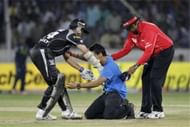The origin of sports in India can be traced back to the Vedic periods. Sports like chess, badminton, snake-and-ladders, gilli danda, kabaddi, volleyball, kancha, ludo and polo have all originated in India and been further modernized by the countries who adopted them.
Basically, sports evolved when the humans wanted their vacant time after agricultural activities to be put into a constructive area. Moreover, many competition and duels that we see today evolved from those sports activities. India probably has the oldest origins of many sports in the world. There are some well-defined values like the mantra in the Atharva-Veda which says, “Duty is in my right hand and the fruits of victory in my left”.
There is also a fascinating link between Greece and India that has developed through sports, which stretches back to 975 B.C. The Modern Olympic Society always had India in mind while drafting down the oath and various disciplines. Today’s Olympic oath – “For the honour of my country, and glory of my sport” is a mere translation of a Vedic chant into English dialect.
What the world is today wouldn’t have been the same if it had no sports; sports have been the silent catalyst in fabricating the physical culture of the people.
Our ancestors utilized sports in the best possible manner. In the Vedic era, sports were believed to be integral to the Gurukul from of education. Education that time was not limited to the chemical reactions or double entry book keeping system; it had vast curricula, which produced a wise student, competent even at physical activities; a better product than today’s textbook slaves.
Today, sports has a completely different perspective. People are only interested in following a sport rather than playing it. I see young students discouraged from taking up sports. Today, all parents want is for their kids to land a fancy job that pays good money.
A sport now has more followers than players who represent it due to modernization and technological advancements. Live television broadcasting has taken sports fanaticism to a different level. For example, 10,000 people watched the first Manchester Derby (football game between Manchester United and Manchester City) played in 1881 while over 10 million people witnessed the Manchester Derby played in the FA Cup semi-final in 2010-11. Television, online streaming and other auxiliaries to broadcast sports events over a terrestrial network have lead to enormous following of sports unlike the older days.
Sports fanaticism has become an addiction today and this can be broadly divided into two categories. One would be “single line” wherein people follow a single sport, and the other a wider “multi-dimensional” fanaticism. Countries like Australia, USA, France and Singapore fall in the latter category whereas countries like India, Pakistan, Cote de Ivory and Republic of Ireland can be put in the bracket of “single line sports fanaticism.”
Cricket has dominated the country over the past four or five decades and has become a discussion topic at cafeterias and with friends. The 2011 World Cup victory was special as the people showed their happiness and connect with the sport. Now this may be a top story in India or New Zealand but it wouldn’t even be on the news in a country like Argentina, Nigeria or Denmark. Cricket is a sport predominantly played and watched by the Asian sub-continent, Australia and England.
It is clear that out of the pool of all the sports available, cricket will fall in the bracket of the sports which need the least amount of human endurance. Why we Indians find cricket as the most lucrative and attractive sport will forever remain a question. Obviously, we can develop various theories to answer this question but none of them can give a concrete answer.
One of the possible theories could be that we don’t like to exert ourselves too much. We don’t have the physical endurance required for athletics and football. Indians are always taught to become escapists by nature – at home, at school, from any environment really. This trait could be a theory: “Cricket is a sport – so we are doing a task.” Whereas in other sports like football, which are a test of human limits, we are ranked in the 160′s. Surely that was not how we were in the older days.
Being a single-line sports country has made obstacles for development of other sports in the country. You might be able to name the whole team that represented the country at the 2011 Cricket World Cup, but most of you would not know who PD Chaugule was. Chaugule was the first Indian who represented the country at the 1920 Summer Olympics in Belgium and took that same oath: “For the honour of my country, and glory of my sport.”
Brand-new app in a brand-new avatar! Download CricRocket for fast cricket scores, rocket flicks, super notifications and much more! 🚀☄️

